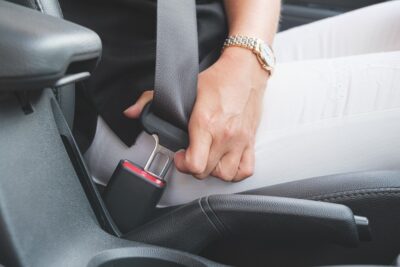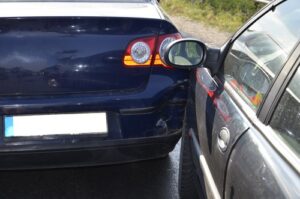
Wearing a seat belt is a life-or-death decision. In the event of an accident, your seatbelt is designed to prevent you from being thrown from the vehicle, avoid excessive impact with an airbag, reduce injury, and so much more. It can become a double-edged sword in the event that the seat belt contributes to your injuries.
If you or a loved one have been involved in a car accident, be sure to report the accident and seek out medical attention. An Atlanta car accident lawyer from John Foy and Associates can help you get the compensation you deserve. Reach out today for more details.
Top Three Causes of Seat Belt Injuries
Level of Force
The amount of force can vary for seat belt injuries, which affects the severity of trauma an occupant may sustain. The nature and location of injuries may also change depending on the direction the impact is coming from. For example, being rear-ended is often associated with serious seatbelt and road traffic collision injuries due to the extra force generated by impact and forward momentum.
Incorrect Fit
When seat belts fit incorrectly, a person is at higher risk of sustaining injuries in the event of an accident. Even though seat belts significantly lower mortality rates and injury levels, their close proximity to soft tissues and vital organs is what makes them more prone to causing damage to the body. Additionally, seat belts should not be placed under the arms or behind the back.
Faulty Restraints
Faulty seat belt mechanisms can be a considerable factor in seat belt injuries, especially in the event the seat belt is older or does not retract sufficiently upon impact. When considering what causes seat belt failure and the best ways to avoid it, monitoring recall information for your vehicle is recommended.
Get the strong arm
Common Seat Belt Injuries in Car Accidents
Seat belts, whether faulty or working properly, can carry a risk of injury to the wearer. Seat belts are meant to restrain motorists and actively lower death rates, but with enough force, they can put excessive pressure on organs, bones, and soft tissues. The following are injuries commonly caused by seat belts.
Head Injuries
If a seat belt isn’t providing enough restraint, a vehicle’s occupant may hit their head against various surfaces in the car, including the steering wheel. Additionally, airbags can lead to head injuries if a person hits it with enough speed and/or force. Whether it’s a concussion, fracture, or a far more serious traumatic brain injury (TBI), a head injury should always be taken seriously and examined immediately.
Neck, Spine, and Chest Injuries
The neck, spine, and chest are common areas of impact in a car accident, as they typically absorb a significant amount of force dispersed by the seat belt. The neck often bears much of the impact and can contribute to spine and chest problems. Bruising, lacerations, and fractures are some of the ways these sensitive areas may be affected.
Chance fractures, in particular, are commonly associated with seat belt injuries. Chance fractures are typically located in the mid-to-lower portion of the spine and lead to spinal instability. They are not always noticeable after an accident but are often found alongside abdominal injuries.
Internal and Abdominal Injuries
Internal injuries are one of the biggest concerns where seat belt accidents are concerned. The placement of the seatbelt, level of trauma, and force of impact can lead to internal bleeding and bruising of abdominal organs and tissue. Because these injuries aren’t always externally noticeable, it is imperative to have a medical professional assess all injuries.
Additionally, organs can become lacerated or perforated as a result of a seat belt. When tissue and organs sustain a tear or cut, this is known as a laceration. Organ perforation occurs when there is leakage from a hole in the organ wall, which can, in turn, lead to infection in the abdomen.
Laceration and Bone Injuries
Seat belts may cause external lacerations, bruising, and/or broken or fractured bones during a car accident. The ribs, clavicle, sternum, and shoulders are particularly susceptible to fractures. Lacerations can vary in depth, location, and dimensions.
Whiplash
Whiplash occurs when sudden movements hyperextend or compress the neck and/or spine through unnatural and forward momentum. The force of an accident causes the body to be thrown forward and hinge around the seat belt, which acts as a fulcrum. Depending on the severity of whiplash, symptoms can include
- Stiffness
- Pain
- Muscle weakness
- Headaches
- Numbness
- Neurological issues
Seek Medical Attention Immediately After a Car Accident
It is important to always seek medical attention after you’ve been in an accident — even if you do not appear to be injured. Depending on the nature and force of the crash, injuries may be more internal than external. This can be especially true of seat belt injuries in car accidents.
According to the National Library of Medicine link above, they recommend that a person’s breathing, air passages, and circulation are among the first functions checked following an accident. Blood work, imaging, and x-rays should also be conducted, among other tests, to determine the extent of a person’s seat belt injuries.
A Properly Fitted Seat Belt Reduces Risks
Making sure you and your loved one’s seat belts are fitted properly can reduce the risk of injuries in a car accident. According to the National Highway Traffic Safety Administration (NHTSA) link above, your seat belt should fit in the following manner:
- Secure the seat belt over the pelvis, hips, and ribcage
- The shoulder belt should lay in the middle of your chest rather than by your neck
- Use seat belt adjusters or extenders as needed
- Ensure proper fit adjustments are made for children, teens, and pregnant women
Seat Belts Save Lives
The NHTSA reports that 50% of deaths from car accidents were due to a lack of seatbelts. While seat belts can cause injuries to vehicle occupants, there is still far less risk to those who wear them than those who don’t. Seat belts consistently save countless lives and should be worn at all times to minimize the risk of death.
Contact a Car Accident Lawyer Today
If you’ve suffered seat belt injuries, let an Atlanta car accident lawyer from John Foy & Associates represent you. We will fight for the compensation you deserve. Contact us for your free consultation today to discuss the details of your case.
(404) 400-4000 or complete a Free Case Evaluation form





